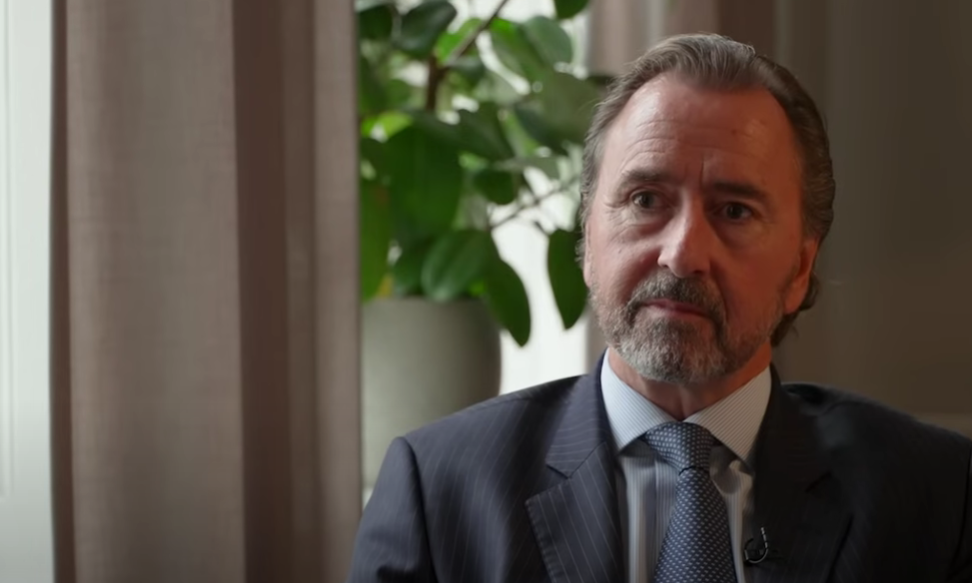Marknadsnyheter
Imfinzi granted Priority Review in the US for patients with muscle-invasive bladder cancer
Decision based on NIAGARA Phase III trial results which demonstrated a statistically significant and clinically meaningful event-free and overall survival benefit. If approved, this will be the first and only perioperative immunotherapy regimen in this curative-intent setting.
AstraZeneca’s supplemental Biologics License Application (sBLA) for Imfinzi (durvalumab) has been accepted and granted Priority Review in the US for the treatment of patients with muscle-invasive bladder cancer (MIBC).
The Food and Drug Administration (FDA) grants Priority Review to applications for medicines that, if approved, would offer significant improvements over available options by demonstrating safety or efficacy improvements, preventing serious conditions or enhancing patient compliance.1 The Prescription Drug User Fee Act date, the FDA action date for their regulatory decision, is anticipated during the second quarter of 2025.
Approximately one in four patients with bladder cancer has evidence of the tumour invading the muscle wall of the bladder (without distant metastases), known as MIBC.2,3 In MIBC, a curative-intent setting, approximately 117,000 patients are treated with current standard of care.4 Standard treatment includes neoadjuvant chemotherapy and radical cystectomy. However, even after cystectomy, patients experience high rates of disease recurrence and a poor prognosis.5
Susan Galbraith, Executive Vice President, Oncology R&D, AstraZeneca, said: “New options for muscle-invasive bladder cancer are vital because nearly half of patients will see their cancer return or progress despite undergoing curative-intent treatment, including removal of their bladder. Today’s Priority Review designation recognises the urgent need for new options for these patients and the potential of Imfinzi to transform the standard of care as the first and only perioperative immunotherapy regimen to delay recurrence and extend survival in this setting.”
The sBLA is based on data from the NIAGARA Phase III trial which was presented during a Presidential Symposium at the 2024 European Society for Medical Oncology (ESMO) Congress and simultaneously published in The New England Journal of Medicine.
In the trial, patients were treated with Imfinzi in combination with neoadjuvant chemotherapy before radical cystectomy followed by Imfinzi as adjuvant monotherapy, or neoadjuvant chemotherapy before radical cystectomy. In a planned interim analysis, perioperative Imfinzi demonstrated a 32% reduction in the risk of disease progression, recurrence, not undergoing surgery, or death versus neoadjuvant chemotherapy with radical cystectomy alone (based on event-free survival [EFS] hazard ratio [HR] of 0.68; 95% confidence interval [CI] 0.56-0.82; p<0.0001). Estimated median EFS was not yet reached for the Imfinzi arm versus 46.1 months for the comparator arm. An estimated 67.8% of patients treated with the Imfinzi regimen were event free at two years compared to 59.8% in the comparator arm.
Results from the key secondary endpoint of overall survival (OS) showed that the Imfinzi perioperative regimen reduced the risk of death by 25% versus neoadjuvant chemotherapy with radical cystectomy (based on OS HR of 0.75; 95% CI 0.59-0.93; p=0.0106). Median survival was not yet reached for either arm. An estimated 82.2% of patients treated with the Imfinzi regimen were alive at two years compared to 75.2% in the comparator arm.
Imfinzi was generally well tolerated, and no new safety signals were observed in the neoadjuvant and adjuvant settings. Further, adding Imfinzi to neoadjuvant chemotherapy was consistent with the known profiles of the individual agents and did not impact patients’ ability to complete four cycles of chemotherapy or undergo surgery compared to neoadjuvant chemotherapy alone.
Regulatory applications are currently under review in the EU, Japan and several other countries based on the NIAGARA results.
Notes
Muscle-invasive bladder cancer
Bladder cancer is the 9th most common cancer in the world, with more than 614,000 patients diagnosed each year.6 The most common type of bladder cancer is urothelial carcinoma, which begins in the urothelial cells of the urinary tract.7 Approximately 50% of patients who undergo bladder removal surgery experience disease recurrence.5 Treatment options that prevent disease recurrence after surgery are critically needed in this curative-intent setting.
NIAGARA
NIAGARA is a randomised, open-label, multi-centre, global Phase III trial evaluating perioperative Imfinzi as treatment for patients with MIBC before and after radical cystectomy. In the trial, 1,063 patients were randomised to receive Imfinzi plus neoadjuvant chemotherapy prior to cystectomy followed by Imfinzi, or neoadjuvant chemotherapy alone prior to cystectomy with no further treatment after surgery. NIAGARA is the largest global Phase III trial in this setting.
The trial is being conducted at 192 centres across 22 countries including in North America, South America, Europe, Australia and Asia. Its dual primary endpoints are EFS and pathologic complete response. Key secondary endpoints are OS and safety.
Imfinzi
Imfinzi (durvalumab) is a human monoclonal antibody that binds to the PD-L1 protein and blocks the interaction of PD-L1 with the PD-1 and CD80 proteins, countering the tumour’s immune-evading tactics and releasing the inhibition of immune responses.
Imfinzi is the only approved immunotherapy and the global standard of care in the curative-intent setting of unresectable, Stage III non-small cell lung cancer (NSCLC) in patients whose disease has not progressed after chemoradiotherapy. Additionally, Imfinzi is approved for limited-stage small cell lung cancer (SCLC) in patients whose disease has not progressed following concurrent platinum-based chemoradiotherapy; as a perioperative treatment in combination with neoadjuvant chemotherapy in resectable NSCLC; in combination with chemotherapy (etoposide and either carboplatin or cisplatin) for the treatment of extensive-stage SCLC; and in combination with a short course of Imjudo (tremelimumab) and chemotherapy for the treatment of metastatic NSCLC.
In addition to its indications in lung cancers, Imfinzi is approved in combination with chemotherapy (gemcitabine plus cisplatin) in locally advanced or metastatic biliary tract cancer and in combination with Imjudo in unresectable hepatocellular carcinoma (HCC). Imfinzi is also approved as a monotherapy in unresectable HCC in Japan and the EU.
Imfinzi is also approved in combination with chemotherapy (carboplatin and paclitaxel) followed by Imfinzi monotherapy in primary advanced or recurrent endometrial cancer that is mismatch repair deficient (dMMR) in the US. In the EU, Imfinzi plus chemotherapy followed by Lynparza (olaparib) and Imfinzi is approved for patients with mismatch repair proficient (pMMR) advanced or recurrent endometrial cancer, and Imfinzi plus chemotherapy followed by Imfinzi alone is approved for patients with dMMR disease. In Japan, Imfinzi plus chemotherapy followed by Imfinzi monotherapy has also been approved as 1st-line treatment in primary advanced or recurrent endometrial cancer, and Imfinzi plus chemotherapy followed by Imfinzi and Lynparza has been approved for patients with pMMR disease.
Since the first approval in May 2017, more than 374,000 patients have been treated with Imfinzi. As part of a broad development programme, Imfinzi is being tested as a single treatment and in combinations with other anti-cancer treatments for patients with SCLC, NSCLC, bladder cancer, breast cancer, several gastrointestinal and gynaecologic cancers, and other solid tumours.
AstraZeneca in immuno-oncology (IO)
AstraZeneca is a pioneer in introducing the concept of immunotherapy into dedicated clinical areas of high unmet medical need. The Company has a comprehensive and diverse IO portfolio and pipeline anchored in immunotherapies designed to overcome evasion of the anti-tumour immune response and stimulate the body’s immune system to attack tumours.
AstraZeneca strives to redefine cancer care and help transform outcomes for patients with Imfinzi as a monotherapy and in combination with Imjudo as well as other novel immunotherapies and modalities. The Company is also investigating next-generation immunotherapies like bispecific antibodies and therapeutics that harness different aspects of immunity to target cancer, including cell therapy and T-cell engagers.
AstraZeneca is pursuing an innovative clinical strategy to bring IO-based therapies that deliver long-term survival to new settings across a wide range of cancer types. The Company is focused on exploring novel combination approaches to help prevent treatment resistance and drive longer immune responses. With an extensive clinical programme, the Company also champions the use of IO treatment in earlier disease stages, where there is the greatest potential for cure.
AstraZeneca in oncology
AstraZeneca is leading a revolution in oncology with the ambition to provide cures for cancer in every form, following the science to understand cancer and all its complexities to discover, develop and deliver life-changing medicines to patients.
The Company’s focus is on some of the most challenging cancers. It is through persistent innovation that AstraZeneca has built one of the most diverse portfolios and pipelines in the industry, with the potential to catalyse changes in the practice of medicine and transform the patient experience.
AstraZeneca has the vision to redefine cancer care and, one day, eliminate cancer as a cause of death.
AstraZeneca
AstraZeneca (LSE/STO/Nasdaq: AZN) is a global, science-led biopharmaceutical company that focuses on the discovery, development, and commercialisation of prescription medicines in Oncology, Rare Diseases, and BioPharmaceuticals, including Cardiovascular, Renal & Metabolism, and Respiratory & Immunology. Based in Cambridge, UK, AstraZeneca’s innovative medicines are sold in more than 125 countries and used by millions of patients worldwide. Please visit astrazeneca.com and follow the Company on social media @AstraZeneca.
Contacts
For details on how to contact the Investor Relations Team, please click here. For Media contacts, click here.
References
- FDA. Priority Review. Available at: https://www.fda.gov/patients/fast-track-breakthrough-therapy-accelerated-approval-priority-review/priority-review. Accessed December 2024.
- Burger M, et al. Epidemiology and Risk Factors of Urothelial Bladder Cancer. Eur Urol. 2013;63(2):234-241.
- National Collaborating Centre for Cancer. Bladder Cancer: Diagnosis and Management. London: National Institute for Health and Care Excellence (NICE). Available at: https://www.ncbi.nlm.nih.gov/books/NBK356289. Accessed December 2024.
- Cerner CancerMPact database. Accessed December 2024. Reflects epidemiology estimates across G8 countries (US, EU, Japan, China).
- Witjes JA, et al. EAU Guidelines on Muscle-invasive and Metastatic Bladder Cancer. Eur Urol. 2021;1-94.
- World Health Organization. International Agency for Research on Cancer. Bladder Fact Sheet. Available at: https://gco.iarc.who.int/media/globocan/factsheets/cancers/30-bladder-fact-sheet.pdf. Accessed December 2024.
- American Cancer Society. What Is Bladder Cancer? Available at: https://www.cancer.org/cancer/bladder-cancer/about/what-is-bladder-cancer.html. Accessed December 2024.
Marknadsnyheter
JRS chefsstrateg Torbjörn Söderberg om börsen framåt

JRS chefsstrateg Torbjörn Söderberg pratar med Jesper Norberg på EFN om börsens väg framåt. Man tar upp värderingar och makro, samt hur han själv väljer att agera.
Marknadsnyheter
Kreditkort skapar problem för USAs konsumenter – CNBC granskar

CNBC tittar närmare på hur kreditkort skapar problem för konsumenterna i USA som får betala räntor på upp till 36 %, och ovanpå det kommer nya avgifter. När det skapar så här stora problem blir det ett problem för ekonomin som helhet, det är inte bara ett individuellt problem.
CNBC granskar kreditkort och problemen de skapar
Vi skrev nyligen om rekordhög belåning hos investerare i USA. Det är samma sak här, när det är så många individer som är så hårt belånade blir det ett problem för hela aktiemarknaden.
Marknadsnyheter
Varför går det så dåligt för Las Vegas?

Det pratas mycket om att Las Vegas har blivit tomt. Det kommer färre besökare både från USA och utlandet, i en sådan omfattning att vägar som förut var fyllda med bilar nu är smidiga att ta sig fram på. De enda som fortsatt verkar komma är affärsresenärerna.
Las Vegas får mycket kritik för att ha blivit för giriga. Hotellen har börjat lägga på alla möjliga konstiga avgifter för att tjäna mer, restaurangerna lägger på avgifter och dessutom har det tillkommit flera nya skatter. Besökarna känner sig lurade.
-
Analys från DailyFX10 år ago
EUR/USD Flirts with Monthly Close Under 30 Year Trendline
-
Marknadsnyheter5 år ago
BrainCool AB (publ): erhåller bidrag (grant) om 0,9 MSEK från Vinnova för bolagets projekt inom behandling av covid-19 patienter med hög feber
-

 Marknadsnyheter3 år ago
Marknadsnyheter3 år agoUpptäck de bästa verktygen för att analysera Bitcoin!
-
Analys från DailyFX12 år ago
Japanese Yen Breakout or Fakeout? ZAR/JPY May Provide the Answer
-

 Marknadsnyheter2 år ago
Marknadsnyheter2 år agoDärför föredrar svenska spelare att spela via mobiltelefonen
-
Analys från DailyFX12 år ago
Price & Time: Key Levels to Watch in the Aftermath of NFP
-
Analys från DailyFX8 år ago
Gold Prices Falter at Resistance: Is the Bullish Run Finished?
-

 Nyheter7 år ago
Nyheter7 år agoTeknisk analys med Martin Hallström och Nils Brobacke

